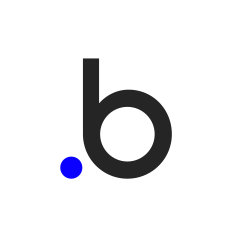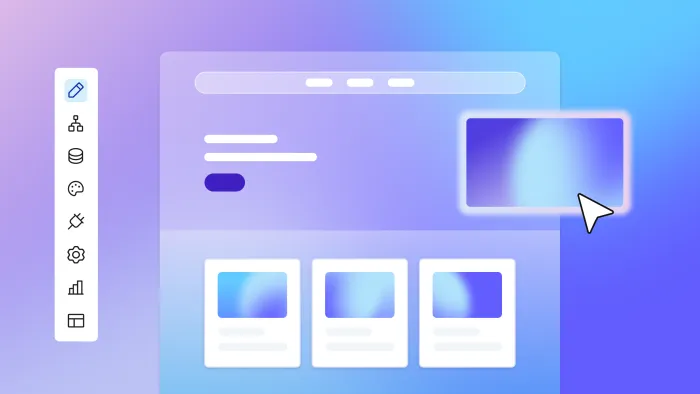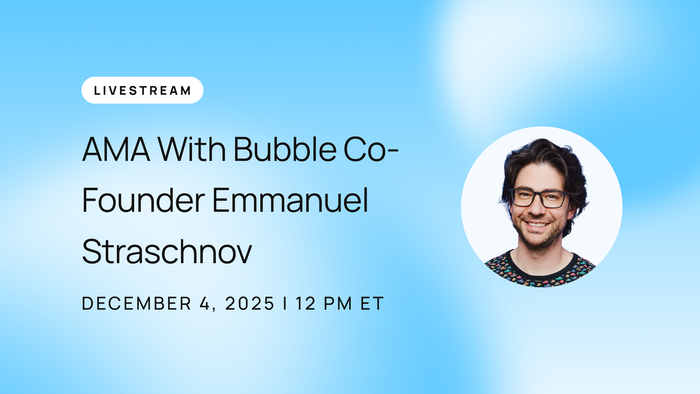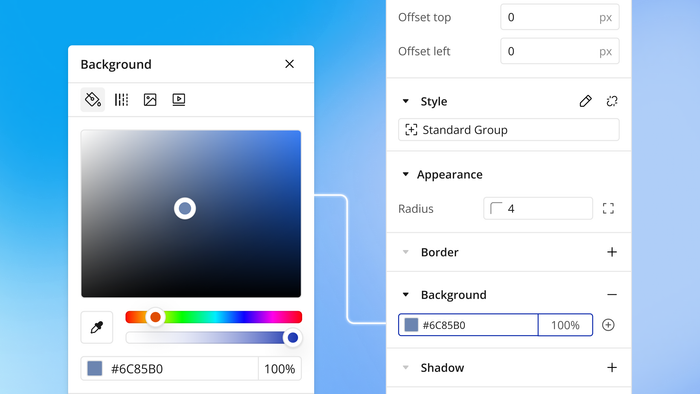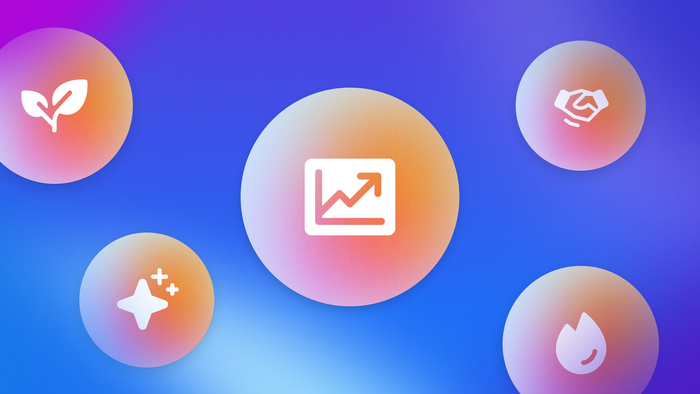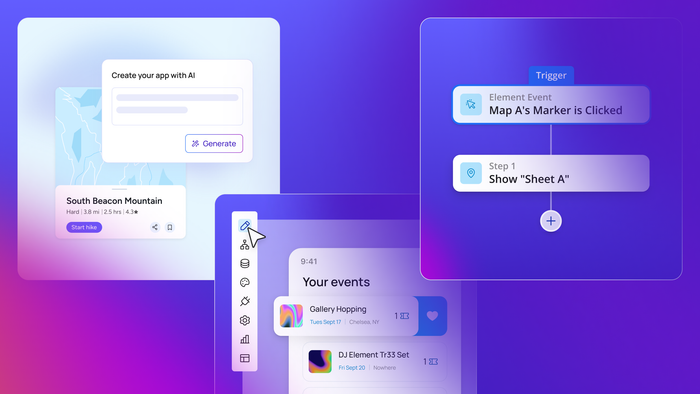The promise is compelling: “Just describe what you want, and AI will build your app.” Over the last year or so, vibe-coding tools like Lovable, V0, and Replit have captured headlines with demos of apps being created instantly through natural language prompts. The excitement was genuine, the possibilities seemed endless, and the narrative was clear — anyone can use these tools to build software, fast.
But today, with real projects on the line and businesses depending on these tools, we wanted to know: What’s actually working when builders need to ship production-grade apps?
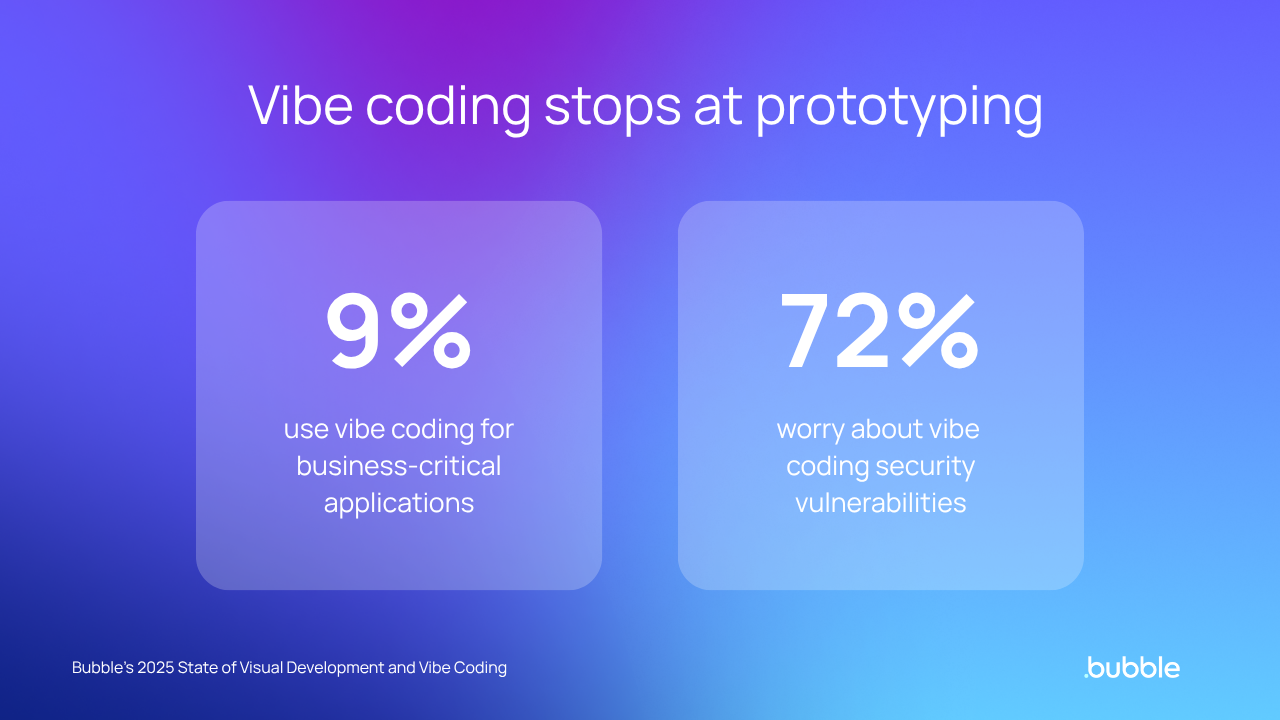
We surveyed 793 current and former Bubble users — a community that’s had the freedom and technical curiosity to use vibe-coding platforms alongside visual development. These aren’t people locked into one approach or providing theoretical opinions — they’re builders who’ve tested both technologies with real projects and can compare based on actual experience. The results reveal a substantial gap between the approaches when it comes to confidence, security, and the ability to deliver production-ready apps.
The bottom line: 71.5% of builders feel confident using visual development for mission-critical applications, compared to just 32.5% for vibe coding.
Visual development holds its lead for production apps
The confidence gap isn’t just sentiment — it shows up in what builders actually deploy. When we asked what percentage of their business-critical applications were built using each approach, the results were decisive: 65.2% of builders use visual development for the majority of their apps in production, while only 9% deploy vibe-coding tools for business-critical work.
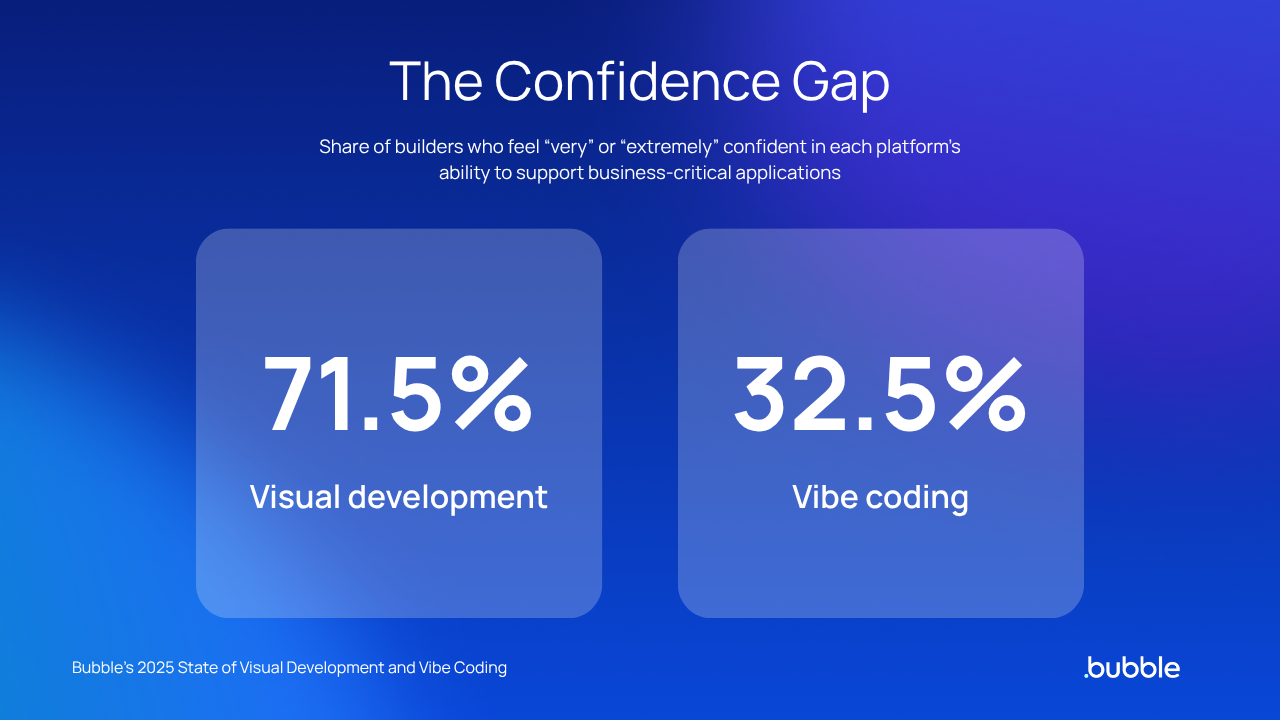
This matters because it’s not about technical capability in theory. It’s about what builders trust when their business depends on it. The builders in our survey have complete freedom to choose any approach they want — many actively use multiple platforms — and when it comes time to ship production applications, visual development wins decisively.
Why does the gap exist? Visual development shows you exactly how your app works, gives you direct control to fix problems when they arise, and provides predictability without “AI black box” uncertainty. Meanwhile, vibe coding excels at rapid prototyping but struggles when you need to debug, customize, and maintain apps over time — what many experienced builders now call “prompt purgatory.”
The security reality: 72% worry about AI-generated code
Security concerns create real hesitation around newer approaches. When we asked builders which development approach they believe is most secure, 52.8% chose visual development — more even than traditional coding (22.7%) or vibe coding (12.6%).
More striking: 72.3% of builders worry about security vulnerabilities in vibe-coding platforms. Only 13.5% said they had no concerns.
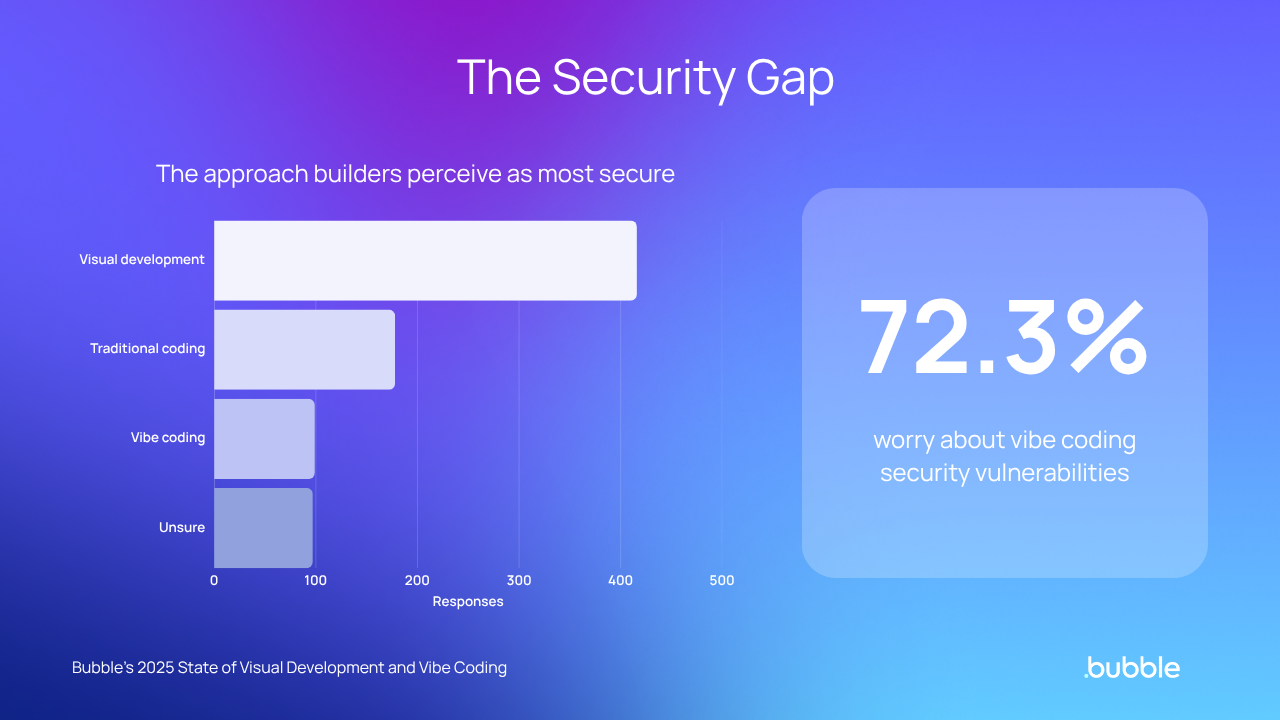
The issue isn’t that vibe-coding tools are deliberately insecure. The problem is transparency. You can’t audit what you can’t understand. Visual development platforms show you exactly how data flows, where privacy rules apply, and how authentication works. With vibe-coded apps, you’re often trusting AI-generated code you can’t fully inspect or verify.
For large applications that require enterprise-grade compliance, audit trails, and security verification, this lack of visibility creates insurmountable barriers to adoption. The 72% of builders who worry about vibe-coding security aren’t being paranoid — they’re being realistic about deploying black-box AI-generated code in production environments.
Real success and real savings across all skill levels
Despite concerns about newer approaches, the data shows that visual development delivers results for builders of all backgrounds.
Success rates prove accessibility works: 87.6% of our respondents told us they’ve successfully completed projects they couldn’t have built otherwise. This includes 77% of complete beginners and 83.2% of non-technical business users. Even professional developers — people who can code traditionally — report that visual development lets them build things they couldn’t have otherwise.
This isn’t about replacing coding ability. It’s about expanding what’s possible.
The business impact is measurable. Nearly 50% of builders saved between $10,000 and $250,000 a year in development costs using visual development tools. When you break it down:
- 27.4% saved $10,000–50,000 annually
- 21.7% saved $50,000–250,000 annually
- 8% saved $250,000 or more
- 2.6% saved $1 million or more
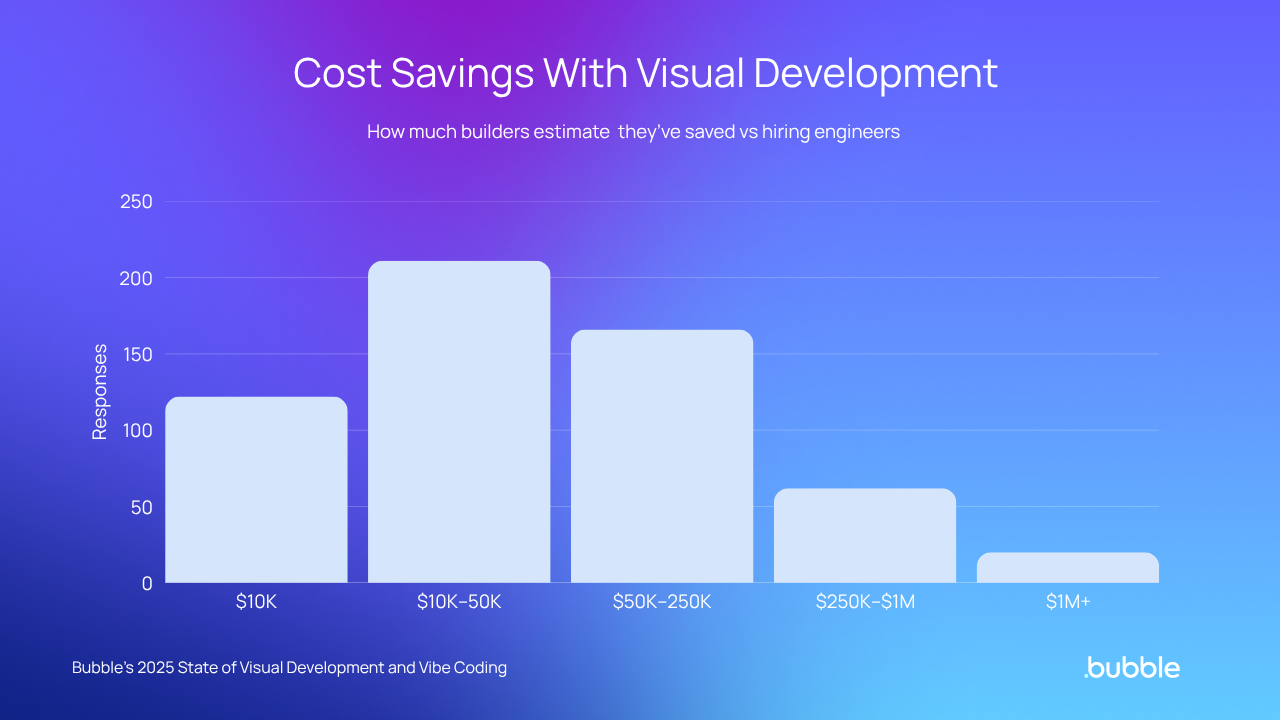
Beyond direct cost savings, 84.9% of builders reported reduced need to hire engineers, with 55.1% seeing significant reductions. For early-stage companies, this is transformational. Instead of raising capital to hire a development team, founders can build and validate their ideas themselves.
The applications being built span real industries: hospital appointment systems, cancer care journal planners, car sharing platforms, mechanical workshop management SaaS, freelancer marketplaces, wine e-commerce with personalized labels, and travel booking platforms. These aren’t toy apps — they’re production-grade applications handling real business operations across healthcare, transportation, enterprise tools, e-commerce, and more.
The right tool for the right job
Both technologies have roles to play, and experienced builders recognize where each excels.
Vibe coding shines at rapid prototyping. 61.2% say it excels at prototyping and iteration. If you need a demo by tomorrow and don’t care about maintaining it long-term, vibe coding delivers. The speed of generation is genuinely impressive, and for concept validation or stakeholder demos, it can be exactly what you need.
Visual development dominates when you need production-ready applications. According to builders, visual development excels at enabling non-technical founders to build real products (64.1%), lowering barriers to entry (58.4%), rapid prototyping (57.9%), and reducing time-to-market (52.4%). It does everything vibe coding does — prototyping, accessibility, speed — while also delivering the control, transparency, and reliability needed for production.
The difference becomes clear in how builders plan to use these tools going forward. 75.7% plan to increase visual development usage in the next 12 months, compared to 50% for vibe coding and just 16.8% for traditional coding.
The hybrid future is emerging: The future isn’t choosing between AI speed and visual control — it’s having both. Platforms that combine AI-powered generation with visual editing capabilities offer the best of both worlds. You get the speed of vibe coding without the “prompt purgatory” that traps builders when AI hits its limits.
As developers increasingly discover, even impressive AI-generated code often needs “real programmers to fix [it].” The solution isn’t abandoning AI — it’s combining AI acceleration with visual tools that give you control when you need it.
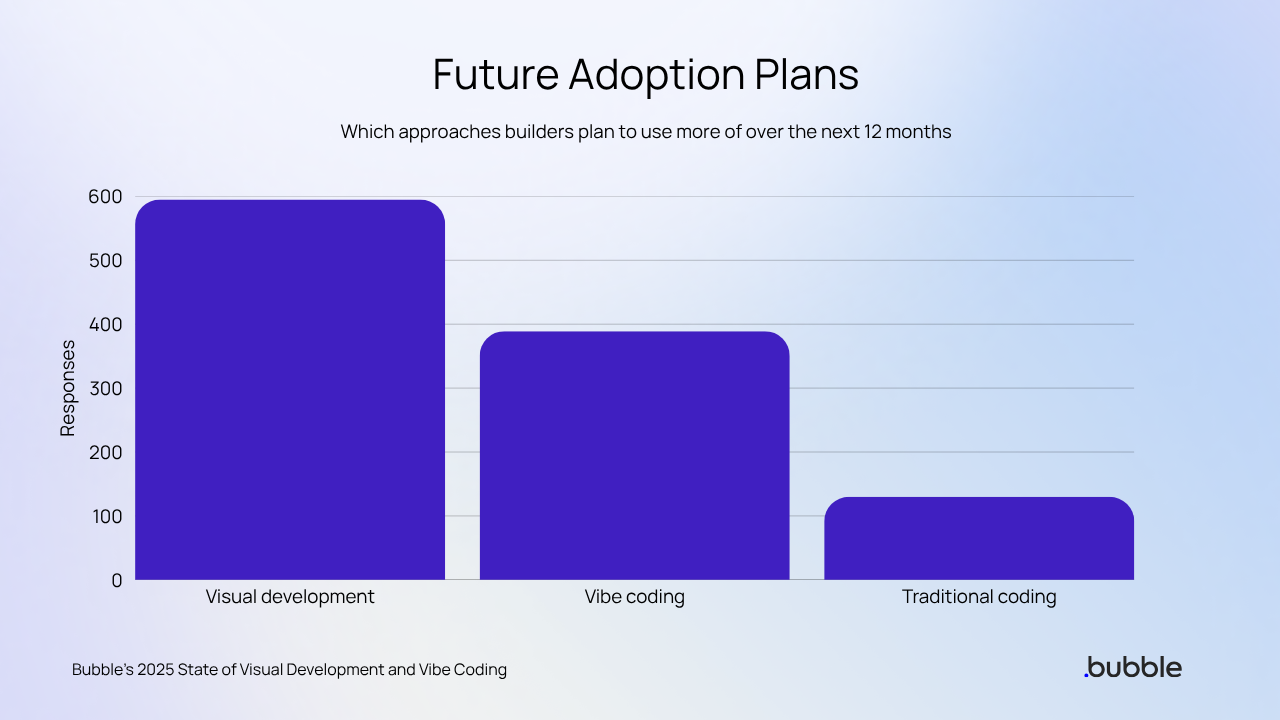
What experienced builders recommend to new entrepreneurs
The clearest signal comes from peer recommendations. When we asked builders what they’d recommend to new entrepreneurs, the gap was substantial:
86.7% would recommend visual development to new entrepreneurs — rating it “absolutely” or “yes, in most cases.”
Only 51.4% would recommend vibe coding, usually with conditions like “only for prototyping” or “if you have coding experience.”
The gap reflects real-world experience. Getting started quickly matters less than finishing successfully. The builders who’ve tested both approaches know that production applications require more than impressive demos — they require control, transparency, and reliability that you can trust when your business depends on it.
The path forward
The AI app building experiment of the past year revealed something important: Speed of generation matters less than the ability to ship, maintain, and scale. Visual development platforms that integrate AI capabilities deliver both speed and control.
Vibe coding has a clear role — prototyping, exploration, concept validation. But when you need production-ready applications, visual development dominates. The confidence gap (71.5% vs 32.5%), the security concerns (72.3% worried), and the recommendations (86.7% vs 51.4%) all point to the same conclusion: The winners will be hybrid platforms combining AI generation with visual editing.
This is exactly the future we’ve been building at Bubble. Generate complete apps with AI and iterate conversationally, but switch to visual editing the moment you need control. See exactly how your app works, fix what AI can’t, and launch something real — not another abandoned prototype. You get AI acceleration for the initial build, visual control for customization and debugging, and production infrastructure from day one.
Read the full 2025 State of Visual Development and Vibe Coding report to explore detailed findings, see complete methodology, and understand what’s working in modern app development.
Start building on Bubble for free to see how AI-powered visual development works for yourself — generate apps with AI, then refine every detail with visual tools. No code required, and you’re never stuck in prompt purgatory.
About this research: We surveyed 793 current and former Bubble builders between September and October 2024, including professional developers (22.7%), founders (36.4%), and complete beginners (14.3%). Importantly, 25.6% actively use vibe-coding tools alongside visual development, providing direct comparison points between approaches. This represents experienced builders reporting on what actually works for production applications, not theoretical preferences.
Build for as long as you want on the Free plan. Only upgrade when you're ready to launch.
Join Bubble